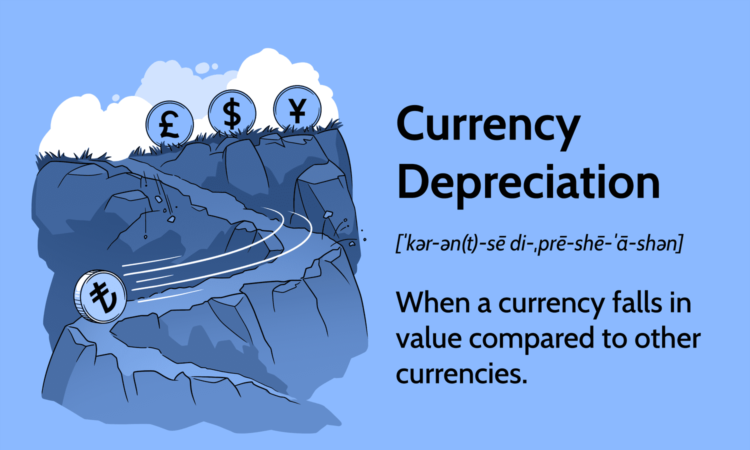
What Is Currency Depreciation?
Currency depreciation is a fall in the value of a currency in terms of its exchange rate versus other currencies. Currency depreciation can occur due to factors such as economic fundamentals, interest rate differentials, political instability, or risk aversion among investors.
Key Takeaways
- Currency depreciation is a fall in the value of a currency in a floating exchange rate system.
- Economic fundamentals, interest rate differentials, political instability, or risk aversion can cause currency depreciation.
- Orderly currency depreciation can increase a country’s export activity as its products and services become cheaper to buy.
- The Federal Reserve’s quantitative easing programs used to stimulate the economy in the aftermath of the 2007-2008 financial crisis caused U.S. dollar depreciation.
- Currency depreciation in one country can spread to other countries.
Investopedia / Mira Norian
Understanding Currency Depreciation
Countries with weak economic fundamentals, such as chronic current account deficits and high rates of inflation, generally have depreciating currencies. Currency depreciation, if orderly and gradual, improves a nation’s export competitiveness and may improve its trade deficit over time. But an abrupt and sizable currency depreciation may scare foreign investors who fear the currency may fall further, leading them to pull portfolio investments out of the country. These actions will put further downward pressure on the currency.
Easy monetary policy and high inflation are two of the leading causes of currency depreciation. When interest rates are low, hundreds of billions of dollars chase the highest yield. Expected interest rate differentials can trigger a bout of currency depreciation. Central banks will increase interest rates to combat inflation as too much inflation can lead to currency depreciation.
Additionally, inflation can lead to higher input costs for exports, which then makes a nation’s exports less competitive in the global markets. This will widen the trade deficit and cause the currency to depreciate.
Quantitative Easing and the Falling USD
In response to the global financial crisis of 2007-2008, the Federal Reserve embarked on three rounds of quantitative easing (QE), which sent bond yields to record lows. Following the Federal Reserve’s announcement of the first round of QE on Nov. 25, 2008, the U.S. dollar (USD) began to depreciate. The U.S. dollar index (USDX) fell by more than 7% in the three weeks after the commencement of QE1.
In 2010, when the Fed embarked on QE2 the result was the same. During the 2010 to 2011 USD depreciation, the greenback hit all-time lows against the Japanese yen (JPY), the Canadian dollar (CAD), and the Australian dollar (AUD).
Political Rhetoric and Currency Depreciation
While economic fundamentals for the most part determine the value of a currency, political rhetoric can cause a currency to fall as well.
Between 2015 and 2016, the U.S. and China were repeatedly in a battle of words with regards to each other’s currency value. In August 2015, the People’s Bank of China (PBOC) devalued the country’s currency, the yuan, by roughly 2% against the U.S. dollar. Chinese officials said the move was required to prevent a further slide in exports.
In 2019, the Trump administration labeled China a currency manipulator, saying Chinese officials were purposely devaluing its currency, leading to unfair advantages on trade. In 2018, U.S.-China political rhetoric turned toward protectionism that resulted in a long-term trade dispute between the world’s two largest economies.
Volatility and Currency Depreciation
Sudden bouts of currency depreciation, especially in emerging markets, inevitably increase the fear of “contagion,” whereby many of these currencies get afflicted by similar investor concerns. Among the most notable was the Asian crisis of 1997 that was triggered by the collapse of the Thai baht that caused a sharp devaluation in most Southeast Asian currencies.
In another example, the currencies of nations such as India and Indonesia traded sharply lower in the summer of 2013 as concern grew that the Federal Reserve was poised to wind down its massive bond purchases. Developed market currencies can also experience periods of extreme volatility. On June 23, 2016, the British pound (GBP) depreciated over 10% against the U.S. dollar after the U.K. voted to leave the European Union, referred to as Brexit.
Example of Currency Depreciation
Turkey’s currency, the lira, lost more than 20% of its value against the USD in August 2018. A combination of factors led to the depreciation. First, investors grew fearful that Turkish companies wouldn’t be able to pay back loans denominated in dollars and euros as the lira continued to fall in value.
Secondly, President Trump approved the doubling of steel and aluminum tariffs imposed on Turkey at a time when there were already fears about the country’s struggling economy. The lira plunged sharply after Trump released the news via a tweet.
Finally, Turkey’s president, Recep Tayyip Erdogan, did not allow Turkey’s central bank to raise interest rates, while at the same time, the country didn’t have a sufficient amount of U.S. dollars to defend its currency on foreign exchange markets. Turkey’s central bank finally lifted interest rates in September 2018 from 17.75% to 24% to stabilize its currency and curb inflation.
More recently, in 2020, the lira has been significantly depreciating due to geopolitical risks as a result of Turkey’s policies in the Middle East and elsewhere. In October 2020, the Lira sank to historic lows. It dropped beyond 8.05 to the U.S. dollar. The lira lost 26% of its value in 2020 and more than 50% since the end of 2017.


